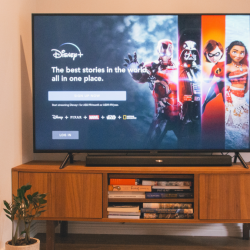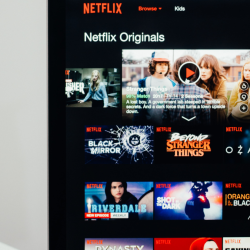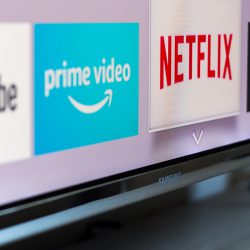TV has always been a media channel admired by advertisers. Brands often put their best efforts into their TV ad creative and appreciate the brand safe and high quality environment that reaches into the heart of the home.
TV has now become even more important to advertisers and consumers alike thanks to the explosion in streaming services and exciting content, from the dramas like global phenomenon Squid Game (2021) and the BBC’s Vigil (2021) in the UK, to comedic game shows like Taskmaster (2015—). Consumers are spending more on video home entertainment than ever before. However, TV is no longer a simple environment: with the rise of connected TV (CTV) audiences have become fragmented across platforms between linear and OTT, enjoying viewing multiple publishers on each.
And the TV is being used for multiple purposes beyond watching programmed content: it’s a gaming device, educator, health coach and more. Smart TV sets have become more complex devices sitting at the heart of the home, offering a changing environment crucial for advertisers to understand.
So, what are the key trends defining the TV landscape for advertisers today?
Device sales mean scale for advertisers
Increasingly, consumers are opting to update their TV set by choosing to purchase a ‘’smart’ connected TV. In fact, the global market is forecast to shift 266 million smart TVs a year by 2025. This is a huge and significant change taking place as the need for a smart TV starts to become as commonplace as having a smartphone in your pocket. Such penetration means an avalanche of exciting and new data-driven insights for advertisers.
Gaming audiences are growing
Gaming is growing in popularity, particularly amongst Gen Z. A recent Deloitte survey found that 87% of Gen Z respondents report playing video games in some form at least once a week. Our gaming report found a 28% increase in the number of Samsung TVs with active monthly gaming activity (from January to June 2021).
Both the gaming community and Gen Z are notoriously difficult demographics for advertisers to reach. However, by understanding gamers we can start to understand viewers: ACR (automatic content recognition) can tell us how to reach action and adventure fans, or those more likely to enjoy puzzles and problem solving.

The majority of our gaming campaigns will include insights gathered using first-party ACR data. This might mean targeting lapsed franchise users by promoting the release of a new franchise, or presenting active users of a particular game with a new expansion pack (Editor’s note: advert for Ubisoft’s Assassin’s Creed: Valhalla‘s two expansion packs, above) . We can also ensure that the launch of a brand new first person shooter game, for example, is only pushed on devices which spend the highest percentage of gaming time on that genre.
Our report also highlighted a key pocket of opportunity to reach gamers, noting a strong overlap between heavy gamers and heavy streamers. UK gamers on Samsung Smart TVs spend on average 28% more time in a streaming environment than the average Samsung Smart TV. What this means is that when gamers aren’t focusing their attention in a ‘lean forward’ environment such as gaming, they tend to be in ‘lean back’ mode watching streaming services instead.
Changing viewing habits
Whilst it’s true that consumers are spending more than ever on their entertainment, budgets are not bottomless. The smart TV allows consumers to access all sorts of content, including free ad supported online video. Currently, a total of 16 million UK households have at least one SVoD account. But growth is slowing, and last year SVoD only amassed 27% more subscribers overall compared to a high of 44% growth in 2020. Many people are starting to re-evaluate their subscriptions as costs increase. Simultaneously, the popularity of traditional television viewing is waning. Deloitte predicts that by 2023 traditional TV broadcasters’ share of viewing hours in the UK will fall to 48%, down from a high of 73% in 2017.

Subscription fatigue combined with a trend away from traditional television content means Advertising-based Video on Demand (AVoD) is poised to grow in popularity. Our report, The 2021 CTV Viewer, found that 56% of viewers are willing to watch ads in exchange for free content. We know that at large, people prefer personalised or more relevant ads: showing that advertisers can make the case to viewers that it’s worth accepting ads for content, if they can make those ads engaging and relevant (Editor’s note: IMDb TV is included as a service for Amazon Prime customers – free streaming content, but with ads).
Importance of discoverability
The expansion of content creation to unprecedented levels leaves viewers with quite the job to find what they want to watch. CTV (connected TV), through smart recommendations enabled by ACR (that’s automatic content recognition), can help audiences navigate their way through this virtual maze of programming. In fact, our recent research with Ipsos found that viewers are open to their TV playing a more proactive role in their viewing, with two thirds (66%) of respondents saying they would be interested in recommendations for shows based on their watch history.
Voice search will become increasingly critical for viewers bored of scrolling, whilst aggregate content recommendations across streaming platforms as part of both the user interface and within app stores, will become defining points of difference that keep consumers engaged. This might look like a smart TV recommending a Netflix show about F1 to big motorsport fans, or suggesting a sci-fi show on Channel 4 to a viewer addicted to Apple TV’s Invasion (above). The need for aggregated content recommendations is exactly why Samsung created the Universal Guide, to provide Smart TV owners with recommendations — based on their viewing behaviours — across multiple linear and streaming services.
Evolution of data and measurement
Measurement solutions are likely to evolve, allowing advertisers to intricately measure the impact of running advanced TV campaigns. ACR is anonymised device level data. The technology offers a highly effective way to gather insights around viewership behaviours on Smart TVs, which gives advertisers access to novel forms of targeted ads.
Advertisers can measure and reach specific audience segments in brand safe environments on the biggest screen in the home, with confidence that not only is the right audience being reached, but that they are not being overexposed to a campaign via linear and CTV ads. This technology is steadily improving alongside external measurement tools, which together can align the channel with other digital ad metrics.
Overall, consumers will continue to want quality content at their convenience, on the biggest screen in the house. As such, we can expect Smart TV purchases to soar. It’s critical that advertisers understand the importance of data and the shift in viewing behaviours — to make more informed media buying decisions.
Featured image: Squid Game / Netflix

































